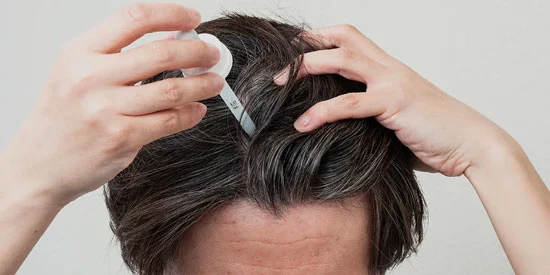Minoxidil powder has become an increasingly popular option for those seeking to address hair loss and promote hair growth. This innovative form of the well-known hair loss treatment offers a convenient alternative to traditional liquid or foam formulations. In this comprehensive guide, we'll explore the proper application techniques for Minoxidil powder, addressing common questions and providing expert insights to help you maximize its effectiveness.

What is the difference between Minoxidil powder and liquid?
Minoxidil powder and fluid are two diverse details of the same dynamic fixing, but they have particular characteristics that can influence their application and adequacy. Understanding these contrasts is pivotal for choosing the right item and accomplishing ideal results.
Minoxidil fluid, the conventional shape, is a arrangement that regularly contains 2% or 5% Minoxidil broken down in a blend of liquor and propylene glycol. This detailing has been broadly utilized and examined for decades, making it a trusted alternative for numerous clients. The fluid is simple to apply straightforwardly to the scalp utilizing a dropper or splash spout, permitting for exact focusing on of influenced areas.
On the other hand, Minoxidil powder is a more later advancement. It comprises of Minoxidil in a dry, powdered frame that is ordinarily blended with a fluid carrier fair some time recently application. This detailing offers a few potential advantages:
- Longer rack life: The powder shape is more steady and less inclined to debasement than fluid solutions.
- Customizable concentration: Clients can alter the concentration of Minoxidil by shifting the sum of powder blended with the carrier liquid.
- Reduced bothering: A few clients discover that the powder shape causes less scalp aggravation compared to alcohol-based fluid solutions.
- Ease of travel: Powder is more helpful to carry and less likely to spill amid travel.
However, the application prepare for Minoxidil powder can be somewhat more included than that of the fluid shape. It requires blending the powder with a carrier fluid some time recently each utilize, which includes an additional step to the schedule. This handle permits for new arrangement of the arrangement, possibly guaranteeing most extreme strength with each application. When comparing the viability of Minoxidil powder versus fluid, it's vital to note that both shapes contain the same dynamic fixing. The essential distinction lies in the conveyance strategy and client involvement. A few people may discover the powder more helpful and less bothering, whereas others may favor the straightforwardness of pre-mixed fluid arrangements.
Ultimately, the choice between Minoxidil powder and liquid often comes down to personal preference and individual response to the treatment. It's advisable to consult with a healthcare professional or dermatologist to determine which form may be most suitable for your specific hair loss concerns and scalp condition.
How long does it take for Minoxidil powder to work?
The timeline for seeing results from Minoxidil powder can vary significantly from person to person, but understanding the general expectations can help users maintain patience and consistency in their treatment regimen. It's important to note that Minoxidil, whether in powder or liquid form, is not an overnight solution for hair loss.
Typically, the first signs of improvement may become noticeable after about 3 to 4 months of regular use. However, it's crucial to understand that this initial progress may not be dramatic. In the early stages, users might observe a reduction in hair loss rather than significant new growth. This is because Minoxidil first works to stabilize existing hair follicles and slow down the rate of hair loss before stimulating new growth.
The full effects of Minoxidil powder usually become more apparent after 6 to 12 months of consistent use. During this period, users may start to see more substantial improvements, including:
- Increased hair density
- Thicker hair strands
- New hair growth in previously thinning areas
It's worth noting that the rate and extent of improvement can be influenced by several factors:
- The underlying cause of hair loss
- The stage and severity of hair loss when treatment begins
- Individual response to Minoxidil
- Consistency in application
- Overall health and lifestyle factors
For some individuals, the results may be more subtle, while others might experience more dramatic improvements. It's also important to understand that Minoxidil is most effective for certain types of hair loss, particularly androgenetic alopecia (male or female pattern baldness). Its efficacy may be limited for other forms of hair loss.
To maximize the chances of success and accurately gauge progress, it's recommended to:
- Take "before" photos prior to starting treatment
- Document progress with regular photos every few months
- Be consistent with applications, following the recommended dosage and frequency
- Continue treatment even if initial results seem slow, as stopping can lead to reversal of any gains
- Combine Minoxidil use with a healthy diet, stress management, and proper hair care practices
It's also crucial to have realistic expectations. While Minoxidil can be effective for many people, it doesn't work for everyone, and results can vary widely. If after 12 months of consistent use there are no noticeable improvements, it may be worth consulting with a dermatologist or hair loss specialist to explore other treatment options or to rule out any underlying health issues that might be contributing to hair loss.
Remember, patience and persistence are key when using Minoxidil powder. The journey to hair regrowth is often gradual, and maintaining a long-term perspective can help users stay motivated throughout the process.
Can you mix Minoxidil powder with water?
The question of whether Minoxidil powder can be mixed with water is a common one among users looking for simple and accessible ways to prepare their hair loss treatment. While water might seem like a straightforward solution, the answer is more nuanced and requires careful consideration to ensure the effectiveness and safety of the treatment.
Minoxidil powder is typically designed to be mixed with a specific type of carrier solution to create an effective topical treatment. In most cases, mixing Minoxidil powder directly with water is not recommended for several reasons:
- Solubility Issues: Minoxidil is not highly soluble in water alone. Without proper solvents, the powder may not dissolve completely, leading to an uneven distribution of the active ingredient and potentially reducing its effectiveness.
- Stability Concerns: A water-only solution may not provide the stability needed to keep the Minoxidil in an active form once applied to the scalp. This could result in reduced efficacy of the treatment.
- Absorption Limitations: The scalp's natural oils can act as a barrier to water-based solutions, potentially limiting the absorption of Minoxidil into the skin where it needs to work.
- Risk of Contamination: Water alone may not provide sufficient antimicrobial properties, potentially increasing the risk of bacterial growth in the solution, especially if stored for extended periods.
Instead of water, Minoxidil powder is typically mixed with a specially formulated carrier solution. These solutions often contain ingredients such as propylene glycol, alcohol, or other solvents that serve several important functions:
- Enhance solubility of Minoxidil
- Improve stability of the solution
- Facilitate better absorption into the scalp
- Provide antimicrobial properties to prevent contamination
Some manufacturers provide a specific mixing solution designed to be used with their Minoxidil powder. If such a solution is not provided or available, users should consult with a pharmacist or the product manufacturer for guidance on appropriate mixing agents.
For those who are sensitive to ingredients commonly found in commercial Minoxidil solutions, such as propylene glycol, there may be alternative carrier options. Some users have reported success with using a mixture of distilled water and food-grade glycerin, or other hypoallergenic solutions recommended by healthcare professionals. However, it's crucial to note that these alternatives should only be considered under professional guidance, as they may affect the efficacy and safety of the treatment.
If you're considering using an alternative mixing solution, here are some important steps to follow:
- Consult with a dermatologist or healthcare provider familiar with Minoxidil treatments.
- Discuss any sensitivities or allergies you may have to common carrier ingredients.
- Ask about potential alternative solutions that may be suitable for your specific situation.
- Follow professional advice on mixing ratios and application methods.
- Monitor your scalp for any adverse reactions when using a new mixture.
It's also worth noting that some users have experimented with pre-mixed liquid Minoxidil solutions as a carrier for the powder form. While this approach may seem logical, it's important to be cautious about potential overdosing and to consult with a healthcare professional before attempting such combinations.
Conclusion
In conclusion, while water alone is generally not recommended for mixing with Minoxidil powder, there are appropriate solutions and potential alternatives available. The key is to ensure that whatever mixing agent is used, it supports the solubility, stability, and efficacy of the Minoxidil while also being safe for scalp application. Always prioritize safety and efficacy by following manufacturer guidelines or seeking professional advice when preparing your Minoxidil treatment.
If you are also interested in this product and want to know more product details, or want to know about other related products, please feel free to contact lea_slsbio@163.com,WhatsApp+86 13193326505.

References
1. Suchonwanit, P., Thammarucha, S., & Leerunyakul, K. (2019). Minoxidil and its use in hair disorders: a review. Drug Design, Development and Therapy, 13, 2777-2786.
2. Badri, T., Nessel, T. A., & Kumar, D. D. (2021). Minoxidil. In StatPearls. StatPearls Publishing.
3. Messenger, A. G., & Rundegren, J. (2004). Minoxidil: mechanisms of action on hair growth. British Journal of Dermatology, 150(2), 186-194.
4. Olsen, E. A., et al. (2002). A randomized clinical trial of 5% topical minoxidil versus 2% topical minoxidil and placebo in the treatment of androgenetic alopecia in men. Journal of the American Academy of Dermatology, 47(3), 377-385.
5. Dhurat, R., & Saraogi, P. (2010). Hair Evaluation Methods: Merits and Demerits. International Journal of Trichology, 2(1), 2-6.
6. Rossi, A., et al. (2012). Minoxidil use in dermatology, side effects and recent patents. Recent Patents on Inflammation & Allergy Drug Discovery, 6(2), 130-136.

